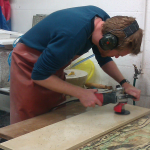
Alasdair Bremner
University of Central Lancashire
abremner@uclan.ac.uk
www.uclan.ac.uk/staff_profiles/dr_alasdair_bremner.php
Biography
Dr Alasdair Bremner is post-doctoral research assistant in the Silicate Research Unit at the University of Central Lancashire (UCLan). He is currently employed on the ‘Aesthetics of Waste’ project commercialising architectural products made from recycled glass and ceramic. His personal research interests include ceramics and refractory concrete and its application in design and art practice.
Illustrated Talk
Collaboration and Print:
Journeys across Disciplines, Dialogues in Print.
Print and Refractory Concrete: new opportunities in scale, surface and durability.
Co- presented with Tracy Hill.
The conference presentation will discuss a recent collaboration between artist printmaker Tracy Hill and ceramic researcher Dr Alasdair Bremner. The aim was to create large format 3D relief prints that retained a print quality, yet were rendered in a durable material. The presentation will discuss the compromises and opportunities that developed from the cross-disciplinary activity.
Tracy has been developing a way of translating the marks from etched metal plates and silkscreen images onto the surface of cast plaster. The direct interaction with this surface and the relationship which resulted between the oil based ink of the etched plate and the surface layer of the water based ink laid down by the silk screen, offered many potential combinations, creating a versatile and unique medium that was printed, yet retained a relief surface. The disadvantage of this process was the fragility of the resulting works. A potential solution was to translate the process into ceramic. Alasdair’s research using castable refractory concrete to create large format architectural ceramics presented a way to achieve pieces that would have the scale and durability that was required. This industrial technology offers the opportunity to achieve the creation of objects that do not conform to some of the traditional limitations of conventional clay yet can make use of a range of ceramic surface treatments.
The challenge of the project was to translate the techniques that Tracy had developed for use in plaster to refractory concrete material, combining the print quality with ceramic glaze qualities. They will discuss the processes developed and highlight the advantages print making in refractory concrete can offer in terms of the interaction of glaze and oxide; the scales possible and finally the durability and permanency. This collaboration opens up new possibilities for printmaking beyond the conventional print within a gallery space.
